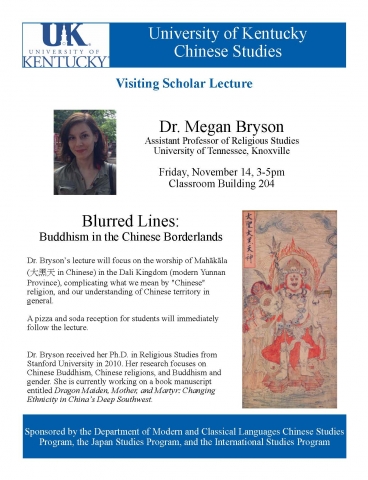Blurred Lines: Buddhism in the Chinese Borderlands


A panel featuring diverse members of the legal profession and Lexington comunity discussing citizen's rights as they relate to law enforcement and recent events surrounding this topic.
Sponsored by the African American & Africana Studies Program and the UK College of Law Student Public Interest Foundation.
Free and open to the public.
The UK Appalachian Center welcomes Fran Ansley on Thursday, November 6, 2014 at 6:30 p.m. Dr. Ansley will screen and discuss the bilingual film Morristown: In the Air and Sun. This event is free and open to the public and will be held at the Village Branch Public Library at 2185 Versailles Rd., Lexington, KY.
Title: An Algebraic Approach to Systems Biology.
Abstract: This talk will present an algebraic perspective for modeling gene regulatory networks. Algebraic models can be represented by polynomials over finite fields. In this setting, several problems relevant to biology can be studied. For instance, the algebraic view has been successfully applied for the development of computational tools to determine the attractors of Boolean Networks, for network inference algorithms, and for the development of a theoretical framework for agent based models. In this talk, the algebraic perspective of discrete models will be applied for control problems. No background in mathematical biology will be assumed for this talk.
Title: Limits, Colimits, and Homotopy . . . Oh, my!
Abstract: Given maps f: X --> Y and g: X --> Z of topological spaces, we obtain a unique map h: X --> Y x Z that respects the appropriate projections. This property corresponds more generally to the limit of a diagram of spaces. In this talk, we will define the limit, colimit, and their homotopy analogs and discuss their universal properties and relative merits/uses. No prior topological knowledge is assumed.
Title: Modeling Foot and Mouth Disease in cattle in northern Cameroon
Abstract: Foot and Mouth Disease (FMD) is endemic in cattle in the Far North Region of Cameroon. While many cattle herds remain in a fixed location throughout the year, there are a small number of mobile herds that migrate depending on the season. These mobile herds share grazing space with many other cattle throughout the year, leading to increased disease transmission. In this talk I will present a multi-scale agent-based simulation model of FMD in northern Cameroon, focusing on the mathematical SIRS epidemic model running both inter- and intra-herd. Various parameters are determined by data from researchers on the ground while others are determined via in silico experimentation. The goal of the first phase of the project is to determine how each herd type contributes to the overall number of secondary infections. This model is a work in progress and the talk is meant to stimulate discussion about means of incorporating epidemic models in a multi-scale setting.
Title: Tropical plane quartics
Abstract: I will begin with a brief introduction to tropical geometry, and explain how algebraic curves give rise to tropical curves. I will then show that every tropical plane quartic admits 7 families of bitangent lines. This is analogous to the remarkable fact in classical geometry that a smooth plane quartic has exactly 28 bitangent lines. While the proof is purely combinatorial, I will discuss recent developments which suggest that the classical and tropical results are closely related. This is joint work with Matt Baker, Ralph Morrison, Nathan Pflueger, and Qingchun Ren.
The College of Arts and Sciences inducted six new members into its Hall of Fame Oct. 10, 2014, with a ceremony at the Singletary Center for the Arts, bringing the current totals to 38 alumni and 13 emeritus faculty A&S Hall of Fame members.
2014 Alumni Inductees:
Ethelee Davidson Baxter
Robert Straus Lipman
Jill M. Rappis
George H. Scherr
2014 Emeriti Faculty Inductees:
George C. Herring
Keith B. MacAdam